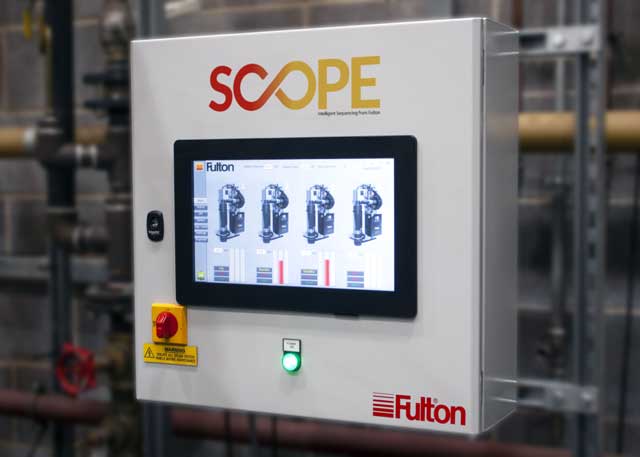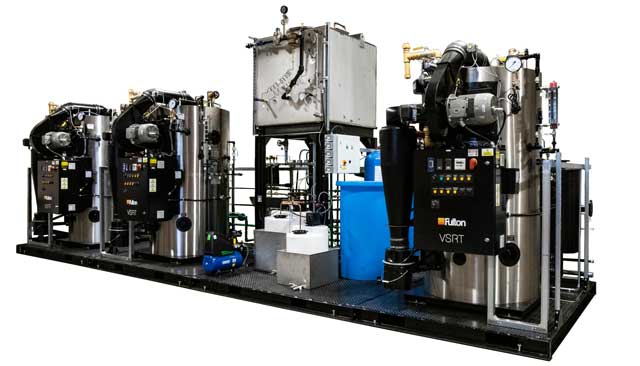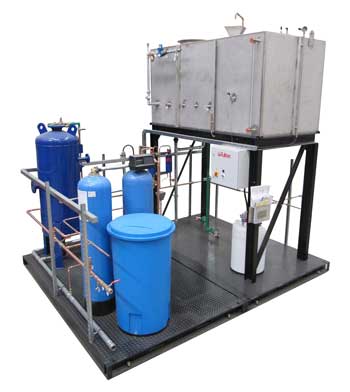
A steam boiler is just one part of an often complex and well-engineered steam system that requires the correct ancillary equipment to ensure process uptime and system longevity. But what are these ancillaries for and why do we need them. In this article, Fulton’s Ruth Price looks into the products that turn a boiler into a fully-fledged process steam solution.
Boiler Sequencing Systems
The use of intelligent sequencing system can provide redundancy and reliability and also offer significant energy savings by automating start-up and shut-down procedures; controlling and optimising main steam header pressure or temperature; ensuring steam supply is controlled precisely for the required process; and balancing the load distribution across the boilers, thus eliminating extensive losses from repeated start/stop cycling of burners as much as is feasibly possible.
Sequencing should be about more than just simply on/off or start-up control. An intelligent sequencing system should also consider steam system load conditions and match this to the most efficient combination of boiler capacity according to the process requirements.
Load response and start-up times are also factors. For example, a boiler sequencing control system should be capable of knowing when running too many or too few boilers is having a negative effect on efficiency and productivity. It should be able to monitor and pre-emptively predict a sudden surge in demand and boiler utilisation by monitoring existing boiler demands, system pressures and flow rates; therefore starting/stopping boilers appropriately depending on the process demands.
Fulton’s recently-launched SCOPE is a universal control system suitable for sequencing up to four steam boilers, which can be retrofitted to existing vertical and horizontal fuel-fired boiler installations, including Fulton’s own range of existing and planned products and those manufactured by other boiler OEMs.

Boiler Feedwater & Condensate Return Tanks
The optimum delivery of feedwater and collection of condensate is essential to the correct operation of a steam boiler system.
Normally of stainless-steel construction, feedwater and condensate return tanks are used to store boiler feedwater and make-up water and are also the vessel that condensate is returned to. As part of an ancillary package, they are usually supplied on a stand which, by elevating the boiler feed water, reduces the risk of cavitating the boiler feed pump. They are also the meeting place for cold make-up water and condensate return; and it’s important that the water within it is kept at a high enough temperature, and mixed well, to minimise the content of dissolved oxygen within the water, which will cause corrosion.
With a boiler of conventional design likely to experience thermal shock when cold water is introduced to its hot surfaces, hotter feedwater means a lower temperature difference and therefore lowers the risk of thermal shock. So, where there is no or limited condensate return due to the process application, the installation of a direct steam injection set to the feed tank is recommended and maintains the feedwater at 85°C or above to aid the removal of dissolved oxygen.
Fulton’s HT boiler feed tank range comprises 11 models, with capacities from 250 to 8,000 litres and use modern level probes and level controls, which provide pump control and extra-low water control to protect feed pumps. A control panel requiring a 240v power supply and feed water solenoid valve is also provided to ensure the predetermined water level and a minimum flow rate for water softeners is maintained. Options include conductive probe level control (including feedwater tundish), temperature gauge, water level gauge (sight glass), steam injection system, chemical dosage unit and guided wave radar level control (where low conductivity water exists).
Blowdown Vessels
Designed to reduce the pressure of the blowdown discharge from the boiler to atmospheric pressure, blowdown vessels also reduce the blowdown discharge-to-drain to acceptable temperatures – usually below 43°C – in line with current water authority bylaws. To do this, a blowdown vessel should incorporate a cooling water system, which facilitates the cooling of standing water in the vessel between scheduled blowdowns. This comprises a self-acting controller with a control valve, stainless steel probe pocket, vacuum breaker, ball valve, check valve and strainer.
With capacities from 15 to 210 litres, Fulton’s blowdown vessel range is CE marked to the Pressure Equipment Directive, constructed and certified to BS EN 13445:2014 and comply with the CEA’s BG03 guidance document on blowdown vessels.

Water Treatment
It is essential that proper water treatment be implemented as part of the design of a steam boiler solution to minimise corrosion and deposition, improve efficiency and prolong the life of the boiler.
With raw incoming feedwater containing impurities that find their way through the main treatment system, the purpose of water treatment/conditioning is to treat and ensure that water is of a quality suitable for a steam boiler. The water treatment process produces soft water by means of ion-exchange, with a minimum water pressure of between 3 and 6 barg required to operate water them.
The main objectives of water treatment are:
- To prevent scale formation from remaining levels of hardness in the pre-treated water
- Sodium phosphate is normally used for this and causes the hardness to precipitate to the bottom of the boiler where it can be blown down
- To deal with any other specific impurities present
- To maintain the correct chemical balance in the boiler water – to prevent corrosion it needs to be slightly alkaline and not acidic
- To condition any suspended matter. This will allow solids to sink to the bottom of the boiler from where it can be blown down
- To provide anti-foaming protection
- To remove and/or neutralise traces of dissolved gases in the boiler plant/system, including oxygen and carbon dioxide, which will cause corrosion and damage
The Fulton water treatment range includes simplex and duplex water softeners, where duplex units are capable of regenerating themselves, while still providing softened water. Bunded chemical dosage set systems are also available, complete with electronically-controlled dosing pumps.
Automatic Bottom Blowdown
Bottom blowdown is essential for removing sludge that forms at the bottom of a boiler and the use of automatic bottom blowdown ensures that this important operation is carried out regularly and releases the boiler attendant for other duties.
A timed-controlled automatic bottom blowdown system allows for automatic bottom blowdown using a timer linked to a pneumatically operated valve. The timer opens the valve at specific pre-configured times, while holding it open for a pre-determined number of seconds.
Automatic Boiler TDS
A Total Dissolved Solids (TDS) system operates by periodically opening a blowdown valve in order to purge the pipework and allow a sample of boiler water past a system sensor.
The controller measures the value of the TDS against the controller set point and if the value is lower than the set point, the blowdown valve closes. If the measured value is higher than the controller set point, the controller continues the blowdown until the measured value drops within the set point range.
The benefits of automatic TDS include:
- Accurate TDS level control reduces blowdown
- Reduction in carryover of boiler water with steam
- Automatic control reduces the requirement for supervision
Sample Cooler
A sample cooler is a small heat exchanger that uses cold water to indirectly cool the blowdown water sample, which would normally be at very high temperatures, thus ensuring a safe means to collect a sample of water from the boiler for accurate analysis. If water is simply drawn from the boiler, a proportion will violently flash to steam as its pressure is reduced. This is not only very dangerous to the operator, but any subsequent analysis will also be inaccurate due to the loss of the flash steam concentrating the sample.
Remote Alarm Panels
Designed to conform to HSE guidance note BG01 regarding the operation of unmanned boiler plant, remote alarm panels allow for the remote shutdown and monitoring of the boiler plant. They are capable of reporting critical alarm conditions – including primary and secondary low water, flame failure, high pressure and high water levels.
To discuss your heat transfer project or for further information on its range of ancillary equipment, call Fulton on +44 (0)117 972 3322, email sales@fulton.co.uk or visit https://www.fulton.co.uk.

